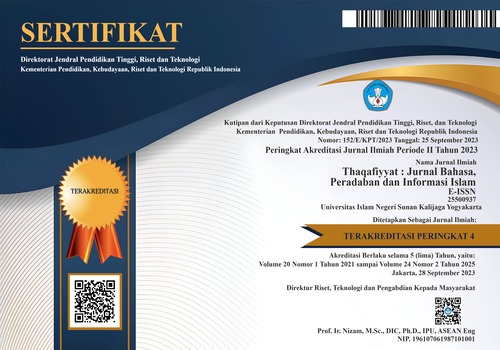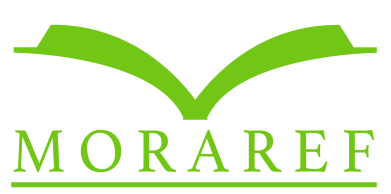
Submissions
Author Guidelines
I. Notes to Authors
A. Discipline Areas
Papers submitted to Thaqāfiyyāt should present a specific account of the work on language, culture, islamic history and civilization, and islamic information. The article must be an original work and has not been previously published.
B. Who Can Submit
Researchers worldwide, either on the basis of language, culture, islamic civilization and islamic information or on other disciplines, may submit their original and rightful article for publication in which a maximum number of five (5) authors in each paper.
Authorship should be limited to those who have made a noticeable contribution to the draft conception, methodological design, data collection, or data analysis of the presented study. All those who have made substantial contributions should be listed as co-authors. If others have participated in certain significant aspects of the paper (e.g. proofreading, data transcribing, or language editing), they should be described in the acknowledgments section.
Each author’s identity must state the full name, institution, email; and ORCID iD; As part of our efforts to improve the transparency of scholarly contributions, each corresponding author must provide their Open Researcher and Contributor Identifier (ORCID) iD; Co-authors are also encouraged to provide ORCID iDs if available. Click this link to register an ORCID iD.
C. General Submission Rules
The article submitted to Thaqāfiyyāt must be original and not published or concurrently submitted for publication elsewhere. The authors should ensure that they have written entirely original works, and if the authors have used the work and/or words of others, that this has been appropriately cited or quoted and permission has been obtained where necessary.
If part of a contribution that authors wish to submit to Thaqāfiyyāt has appeared (or will appear) elsewhere, the author must specify the details in the covering letter accompanying the submission. Consideration by the Editorial Team is possible if neither the conclusion, results, nor implications are identical from the other work. The Managing Editor will consider submissions when the similar work is published in a language other than English and Arabic, or when it contains material that has previously formed part of an academic thesis or Ph.D. dissertation which has been published according to the requirements of the institution awarding the qualification.
D. Screening Process
All manuscripts are subject to a screening process to ensure its sensibility with the focus and scope of Thaqāfiyyāt. Authors could expect a decision within 10 weeks of receipt. If a revision is required, the corresponding author should submit a revised manuscript within 21 days. The final decision is taken by the Editor-in-Chief based on the information gained through the peer-review process.
E. Themed Issues
Thaqāfiyyāt currently does not publish a specific issue. Therefore, the main scope of this journal is language, culture, islamic history and civilization, and islamic information.
II. Categories of Contents
The main form of manuscripts in Thaqāfiyyāt will be peer-reviewed research articles. Its structure can be flexible due to its digital platform, hence allowing authors to explore a variety of formats.
A. Research Article
The research article is a paper containing methodological and theoretical advances on the subject area. The main body of the article should contain an introduction, method, result and discussion, conclusion, and references. This article comprises approximately 4,000-6,000 words including references.
B. Fieldwork Investigation
Most Fieldwork Investigations may fulfil the criteria for the previously ascribed Research Article. However, some cases were conducted in the natural environment rather than in a laboratory or office. These will be similar in length to Research Articles, comprising a total of 5,000-8,000 words.
C. Ongoing Research Report
Articles categorized as an Ongoing Research Report will be brief academic ideas, early research findings, materials, concepts, or questions as a “work in progress”. Research proposals for bachelor/master/doctoral thesis are included in this category. This form of paper shall be thought-provoking, illuminating, and challenging for intellectualism. It comprises approximately 4,000-6,000 words with references.
III. Brief Manuscript Guidelines
A. Paper Layout
The text is single-spaced on A4-paper size, written in The manuscript typed by Microsoft Word, Times New Roman font size 12 pts. All text must be customized into the ‘moderate’ margin [Top: 2.54, Left: 1.91, Bottom: 2.54, Right: 1.91 cm]. The manuscript must also avoid the use of any section break and bold text. Employ italics rather than bold or underlining texts for emphasized sections of the writing (exception for URL address).
B. Authors’ Agreement and Declaration
Thaqafiyyat commited to ensure the transparency and originality of the manuscripts. Therefore, all authors should fill and sign the “Agreement and Declaration Form” when submitting the manuscripts. This form contains agreement and declaration as listed below:
ensuring the transparency and reproducibility of the data;
ensuring that original data are preserved by rigid methods so that it is retrievable for reanalysis;
confirming that the presentation accurately reflects the original data;
foreseeing and minimizing obstacles to the sharing of described data;
C. Referencing Style
Bibliographical management must be adjusted following the Turabian 8th Style (full note). The editorial team highly recommends the use of reference manager software at styling the footnote and the bibliography, such as Zotero, Mendeley, or EndNote.
IV. Paper Structure
The article must be structured as follows:
Abstract
The abstract submitted to Thaqafiyyat should be concise and factual containing the statement of topic, objectives, arguments, and general findings. References are not necessarily needed. The use of abbreviation should be avoided; provided that it is necessary, it should be defined in the initial part of the abstract, e.g. Universitas Islam Negeri (UIN).
Introduction
The introduction should comprise of (1) the study's background, (2) the literature review, (3) the conceptual framework (if necessary), (4) the objectives and goals, and (5) the research approach.
[Background] The initial segment of the introduction needs to present a clear and logical argument supporting the significance or relevance of the study. Evidence from literature must support the idea.
[Literature review] The second segment of the introduction must establish a clear and logical argument demonstrating the originality of the study. The literature review must summarize what is already known about the research query or specific topic and clarify the knowledge gap that the study intends to address. Evidence from literature should back up the argument.
[Conceptual framework] For some research papers, it is essential to describe the underlying theoretical basis for the research and how these theories are interconnected in a conceptual framework. The theory used to construct the conceptual framework should be referenced from the literature.
[Aim and objectives] The introduction should conclude with a clear and concise summary of the study's aim and objectives.
[Research method] Finally, the introduction should contain the methods used to address the research question. The methodology section must explain the steps taken in executing the study. It should provide sufficient detail to convince the reader that the method used is reliable and valid in presenting the findings. This section should include information about the sampling technique, data collection, and sample size.
Body of Article
This section consists of the research results and how they are discussed. Adequate data must support the results obtained from research. The study's results must answer the problem and the research objectives stated earlier in the introduction. Footnote sample.1 Footnote sample.2
The discussion needs to cover the following points:
(1) Determine if the research data has been examined and if it is presented in a visual format such as graphs or charts in addition to a written explanation. This portion typically explains what was discovered and how it was done.
(2) Verify if the author offers a scientific explanation for every result or finding that is presented (the reason behind it).
(3) Assess if the study results are comparable to what other researchers have published, or if there are any discrepancies.
Conclusion
The conclusion should address the research objectives and findings. It should not merely restate the results and discussions or abstract. Additionally, it should suggest avenues for future research and highlight ongoing research.
V. Detailed Final Manuscript Preparation Guidelines
A. Formatting Requirement
Papers submitted for publication must conform to the following requirements:
The paper must be written either in English, Arabic, or Indonesian.
All submissions should be in Microsoft Word, RTF, OpenOffice, or WordPerfect document file format.
All submissions must include 150-200 words of bilingual abstract [English/Arabic and Indonesian].
The abstract should explain; Purposes of the Study, Methodology, Main Findings, and Research Novelty.
The author should present not more than five (5) very specific keywords, each separated with a semicolon (;).
Arabic words should be transliterated according to the style of the Library of Congress (LC) Arabic Romanization Guidelines.
The main body of the article should at least contain; Introduction, Method, Result and Discussion, Conclusion, and References.
The article should provide at least 25 references.
Please make sure that the manuscript does not include any personal information, as it will immediately be sent for the peer-review process.
B. Language and Grammar
All submissions must be in English, Arabic and Indonesian. Authors also should use proper and standard English grammar. UK English is preferred in general, but US English is also acceptable. However, authors cannot mix both. If it is written in Arabic, it must use standard Arabic grammar.
C. Data Availability
Authors are responsible for obtaining all necessary permissions and ensuring compliance with local regulatory requirements for data sharing. Authors should provide information in the manuscript on their data collection methods sufficient to support peer review. If data processing steps were performed by the third party, out of the control of the authors, this should be clearly stated in the methods. Please refer to our journal policy for information about authors’ responsibilities for preserving and making available data and materials upon publication.
All published manuscripts reporting original research in Thaqafiyyat must include a statement of the availability of data. This statement must make the conditions of access to the “minimum dataset” that is necessary to interpret, verify and extend the research in the article, transparent to readers. This minimum dataset may be provided through deposition in public community/discipline-specific repositories, custom proprietary repositories for certain types of datasets, or general repositories. Providing large datasets in supplementary information is strongly discouraged and the preferred approach is to make data available in repositories. Editors reserve the right to decline consideration if a manuscript fails to provide sufficient information regarding the data collection approach.
D. Tables and Figures
Illustrations, figures, and tables are placed within the text at the appropriate points, rather than divided at the end of the discussion. Each of them must be asserted with a brief description.
Thaqafiyyat Template.doc (DOWNLOAD HERE)
Submission Preparation Checklist
All submissions must meet the following requirements.
Copyright Notice
Authors who will publish with this journal agree to the following terms:
- Thaqafiyyat: Jurnal Bahasa, Peradaban dan Informasi Islam publishes all articles entirely in full text.
- It is permissible for readers to download and to use it for scientific purposes and scientific dissemination.
- Authors retain copyright and grant the journal right of first publication with the work simultaneously licensed under a Creative Commons Attribution License that allows others to share the work with an acknowledgement of the work's authorship and initial publication in this journal.
- Authors are able to enter into separate, additional contractual arrangements for the non-exclusive distribution of the journal's published version of the work (e.g., post it to an institutional repository or publish it in a book), with an acknowledgement of its initial publication in this journal.
- Authors are permitted and encouraged to post their work online (e.g., in institutional repositories or on their website) prior to and during the submission process, as it can lead to productive exchanges, as well as earlier and greater citation of published work.








